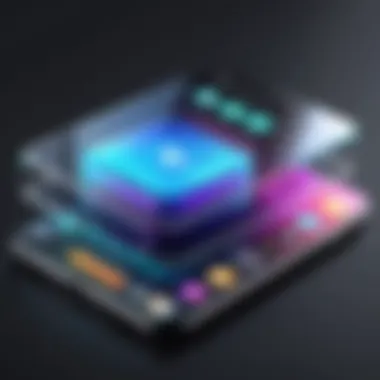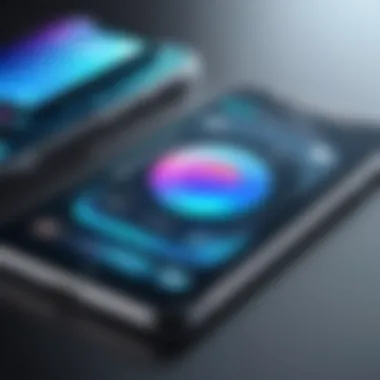Free 3D Apps for iPhone: Features and Insights


Intro
In today’s fast-paced digital world, the concept of creating and manipulating three-dimensional objects has shifted from specialized environments to the palms of our hands. With the advancements in technology, particularly in mobile devices, the capability to work with 3D modeling and design is now widely accessible. This guide aims to give an informative glimpse into the diverse array of free 3D applications available for iPhone users. Whether you are a seasoned IT professional or an enthusiastic hobbyist, diving into these tools could expand your creative horizons in ways you may not have imagined.
The popularity of 3D design is growing rapidly across various fields—art, architecture, game development, and even education. By exploring these applications, users can not only create visually stunning projects but can also learn about spatial awareness, design principles, and technological integration. The range of available apps caters to different skill levels and project types, making it possible for virtually anyone to dive into the 3D world.
As we embark on this exploration, it is worthwhile to understand the core elements that contribute to the effectiveness and appeal of these 3D apps. From user interface designs to the ever-evolving capabilities, each application has something unique to offer. Overall, the intent is to help users navigate through the clutter and discover tools that best suit their particular needs.
A solid grasp on the features and usability of these applications can very well make a difference in how one approaches a project. With crucial factors such as pricing (or note the fact that they are free) and overall user experience in mind, this guide is here to illuminate the landscape of mobile 3D modeling and design for iPhone users.
Foreword to 3D Applications on Mobile Devices
In recent years, the landscape of mobile technology has transformed dramatically, bringing 3D design capabilities right to the fingertips of users. This shift in access is particularly noteworthy given how 3D applications were once confined to powerful desktop machines. Today, users can explore, create, and manipulate 3D models on their iPhones, making this technology more democratic than ever before.
One key reason to focus on 3D applications for mobile is the ability to harness the power of augmented reality (AR) and immersive experiences. Imagine being able to visualize a new piece of furniture in your living room before making a purchase; 3D applications allow you to do just that. For designers, artists, and hobbyists alike, the power of mobile 3D applications opens up new avenues for creativity and innovation.
Additionally, the portability of devices like the iPhone means that users can work on their projects anytime and anywhere, whether they are in a coffee shop or lounging at home. This accessibility encourages experimentation, allowing individuals to try their hand at design without the daunting obligation of investing in expensive software or hardware. As the saying goes, "the best camera is the one you have with you"; this applies to design tools in much the same way. If you have the right app on your device, you have a studio in your pocket.
However, navigating the rapidly evolving ecosystem of mobile 3D apps is not without its challenges. Users should consider the range of functionalities offered by these applications, including modeling, animation, and AR features. Choosing the right app can be a tricky endeavor, especially when weighing factors like user-friendliness, compatibility with other software, and the learning curve associated with each option.
In this guide, we will delve deeper into the various types of 3D applications available for the iPhone, explore their key features, and highlight several top-tier free apps, providing readers with the tools they need to make informed choices.
The Rise of Mobile 3D Design
The surge in mobile 3D design can be attributed to several key factors. First off, there's been an exponential improvement in smartphone hardware. With each generation, devices tend to boast better CPUs, GPUs, and RAM, enabling them to handle increasingly complex tasks. The introduction of sensors and camera technologies has further enhanced the capabilities of mobile applications, making advanced 3D modeling and AR possible.
Furthermore, the user interface and experience have notably evolved. Intuitive touch controls and gesture-based navigation have rendered complex design tasks more manageable than before. People who may have previously avoided 3D design due to perceived complexities find it easier to engage with the technology. 3D applications, tailored for mobile use, often provide tutorials and community support, which break down barriers for newcomers.
Lastly, there's a growing interest in fitness, gaming, and visualization apps that utilize 3D technology. In this atmosphere bustling with creativity and innovation, individuals are eager to experiment with 3D modeling for everything from game design to educational content. Thus, one could say we're witnessing a democratization of design tools, where creativity is enabled by accessible technology.
Why iPhones for 3D Applications?
When considering why the iPhone specifically stands out as an ideal platform for 3D applications, several nuances come into play. One significant aspect is Apple's commitment to hardware and software integration. The seamless experience fostered by iOS ensures that applications can leverage the full capabilities of the device's performance. For example, Apple's metal graphics technology empowers apps to render high-quality graphics with reduced latency.
Moreover, the App Store hosts a treasure trove of 3D applications, catering to different users—from novice creators to seasoned professionals. The richness of options allows users to explore freely and find the tools that best fit their needs. This breadth of software is hard to find in other mobile operating systems.
Security is another factor that puts iPhones a notch above the rest. The stringent app review process ensures quality and safety, which is crucial for those investing their time and resources into learning and creating with these applications. When users know they can trust the apps they are downloading, it reduces the friction in adopting new tools.
Understanding the Types of 3D Apps
When diving into the expansive world of 3D applications on iPhones, it is pivotal to comprehend the different categories of tools available. Each type serves a specific purpose, catering to varied needs, from modeling to animation. Understanding these categories not only streamlines the selection process but also enhances the user's creativity and efficiency.
Modeling Apps
Modeling apps are fundamental for anyone seeking to create three-dimensional objects. These software tools provide users with the capability to sculpt intricate designs, ranging from simple geometric shapes to complex characters or environments. When choosing a modeling app, consider:
- User Interface: A clean and intuitive interface is essential. Users should be able to navigate the app with ease, even if they're new to 3D design.
- Tool Variety: Look for apps that offer a broad range of modeling techniques. Sculpting, extrusion, and manipulation tools can enhance creativity significantly.
- Performance Optimization: Since rendering complex models can be resource-intensive, ensure the app is optimized for mobile use, minimizing lag and crashes.
For example, an app like SculptGL allows users to start with a basic shape and sculpt it into detailed designs, which can then be used in various projects, from games to digital art.
Animation and Rendering Tools
Animation tools take 3D design a step further by bringing static models to life. These apps provide essential functions for users interested in creating animated scenes or characters. Important features to consider include:
- Keyframe Animation: This allows users to define specific points in time for a model's movement, creating smooth transitions.
- Rendering Quality: The ability to generate high-quality visuals can significantly affect the final output, especially for professional presentations.
- Integration Capabilities: Good animation tools should work seamlessly with modeling apps to provide a smooth workflow.


An app like Blender has an excellent reputation in the 3D community for its powerful animation capabilities, though users must be cautious with performance on mobile devices.
Augmented Reality Applications
Augmented Reality (AR) applications revolutionize how we interact with 3D content, allowing digital models to be placed within the real world through the iPhone's camera. These apps are beneficial for various fields, including architecture, education, and gaming. Key points to consider include:
- Real-Time Interaction: Look for apps that allow real-time manipulation of 3D objects in live camera views. This enables immediate visualization of designs in a real-world context.
- User Engagement: Effective AR apps should provide an interactive experience, drawing users deeper into the 3D environment.
- Content Sharing: The opportunity to share AR experiences easily can facilitate collaboration and feedback among peers.
For instance, apps like IKEA Place let users superimpose virtual furniture in their homes, giving an impressive understanding of spatial dynamics.
These classifications help in meticulously navigating the vast options available, ensuring that users can select the right tool for their specific requirements. This understanding serves as a solid foundation for utilizing free 3D apps effectively, whether one is a seasoned professional or a newcomer exploring the exciting realm of 3D design.
Key Features to Look For
When sifting through a myriad of 3D apps vying for your attention, it's easy to feel a tad overwhelmed. However, focusing on specific features can streamline your search and ensure you select an app that aligns with your 3D modeling needs. Let's explore the fundamental elements to keep in mind when scouting for the perfect 3D application on your iPhone.
User Interface Considerations
The user interface (UI) plays a pivotal role in how effectively you can utilize a 3D app. An intuitive layout can make your experience smoother, guiding you through complex tasks with ease. Look for apps that prioritize user experience with clean designs and responsive controls. Common elements to watch for include:
- Ease of navigation: Apps that allow quick access to tools without digging through multiple menus tend to enhance productivity.
- Visual clarity: The arrangement of icons and information should minimize clutter, allowing you to focus on your creative process.
- Customizability: Some apps offer options to tailor the UI according to individual preferences, which can make a significant difference in your workflow.
Keep in mind, a good UI isn’t just about aesthetics; it’s about boosting efficiency so you can create without unnecessary distractions.
Export and File Compatibility
Another critical consideration is how well the app integrates with other software or platforms. You might create stunning 3D models, but if you can't export them in a format compatible with other tools, your efforts could go down the drain. Here are some aspects to ponder:
- Supported file formats: Ensure the app can export in formats like .OBJ, .FBX, or .STL, which are widely accepted in the industry. This versatility can save you time when moving projects between applications.
- Cloud support: Some applications provide seamless syncing with cloud storage services like Google Drive or Dropbox, making your files accessible anywhere.
- Import functionality: Check which file types the app can import. Having a flexible import feature will allow you to incorporate existing models into your projects more easily.
By keeping an eye on these compatibility features, you make sure that your creative possibilities remain as expansive as your imagination.
Support for Tutorials and Community
Learning curves can be steep when diving into 3D modeling. An app that offers robust tutorials can bridge that gap, making the transition smoother and more enjoyable. A strong community can also provide support and inspiration:
- In-app tutorials: Look for apps that offer comprehensive guides, video demos, or step-by-step walkthroughs. These resources can expedite your learning process and inspire creativity.
- Online community: A vibrant online community means more collaboration and shared knowledge. Check forums like Reddit or even Facebook groups where users can exchange tips, tricks, and critiques.
- Access to resources: Some apps maintain databases of user-generated content, plugins, or additional tools that enhance your capabilities significantly.
Having a supportive environment boosts confidence and creativity, making it easier to experiment and explore new techniques without feeling lost.
By focusing on these key features, you'll not only enhance your productivity but also discover an app that truly fits your unique workflow and creative ambitions.
Top Free 3D Apps for iPhone
In today's fast-paced digital sphere, free 3D apps for the iPhone have emerged as essential tools for designers, hobbyists, and anyone curious about 3D modeling. The importance of exploring these applications can't be overstated. With the rise of mobile technology, the ability to create and manipulate 3D objects on the go offers a level of convenience previously unseen in the design world. Many apps cater to various skill levels, making it easier than ever for users to express their creativity.
When it comes to 3D design, the iPhone's powerful hardware combined with these applications allows for intricate modeling, quick editing, and graphic rendering without the need for hefty desktop setups. Each app has its unique features that address specific creative tasks, which means understanding these applications can lead to better project outcomes and a more efficient workflow. Here are three noteworthy free 3D apps that shine on the iPhone, offering robust options suitable for a wide range of users.
App One: Overview and Features
User Interface
The user interface of App One stands out due to its intuitive design that caters not only to seasoned 3D artists but also to novices. The layout is strategically arranged, enabling users to access tools and features with minimal clicks. One key characteristic is the responsive touch controls that allow for rotating and scaling models effortlessly. However, a potential drawback is that some users may find the initial learning curve to be a bit steep due to the sheer variety of options available.
Key Tools


App One packs a punch with its array of key tools for modeling and rendering. A notable feature is the live collaboration functionality, which enables multiple users to work on a project simultaneously. This characteristic enhances productivity and fosters creativity in team settings. Nonetheless, this app might lag on older iPhone models, which could leave users who haven’t upgraded desiring better performance.
Performance Review
In terms of performance, App One is often praised for its fast rendering speeds and responsiveness. The optimization for high-resolution outputs is a significant plus, allowing users to present their designs in stunning detail. However, heavy projects may require more resources than what some older iPhones can provide, which could lead to some frustration during heavy use.
App Two: Overview and Features
User Interface
App Two features a clean and streamlined user interface that emphasizes ease of access. The tutorials embedded into the app further enhance the usability factor, making navigation simpler for beginners. A strong point is its customization options that let users rearrange tools based on personal preferences. On the flip side, more advanced users might feel confined by the straightforward organization, which may lack the depth they crave for complex projects.
Key Tools
Regarding key tools, App Two offers innovative sculpting features that mirror traditional modeling techniques. This characteristic attracts users who prefer a hands-on approach to design. A particularly appealing aspect is the extensive library of material textures. On the downside, accessing these textures can sometimes be cumbersome, requiring several steps before reaching the desired library.
Performance Review
Performance-wise, App Two provides a reliable experience with less lag and smooth transitions between tasks. The rendering engine is optimized for quicker outputs, making it an excellent choice for those under time constraints. That said, users have reported occasional crashes when working on more complex models, which can be a significant setback during critical moments.
App Three: Overview and Features
User Interface
The user interface of App Three leans towards a minimalistic approach. This simplicity allows for a distraction-free experience where users can focus solely on their models. A key characteristic is how the main workspace adapts to user preferences on the fly, which is a breath of fresh air for many. Nonetheless, this app may feel overly simplistic for users looking for advanced capabilities at their fingertips.
Key Tools
App Three integrates unique tools aimed at real-time rendering, which sets it apart from others. The ability to see changes almost instantly as you manipulate your model allows for a fluid workflow. A standout feature is the integration with augmented reality, giving users a chance to visualize their 3D designs in real-world settings. On the downside, while the AR feature is exciting, it might drain battery life quickly if not managed appropriately.
Performance Review
In terms of performance, App Three is commendable, often running smoothly even with intricate designs. Users appreciate the consistent rendering speed, which helps maintain an efficient workflow. However, some reports indicate that larger files can occasionally slow down the app considerably, which may hamper productivity for power users.
Comparison of the Leading Apps
When weighing the effectiveness of these three applications, various elements come into play that help users decide which app best suits their needs.
Performance Metrics
Comparing the performance metrics, App One leads in rendering speeds, while App Two shines with better crash handling. App Three, on the other hand, offers seamless integration with augmented reality, making it unique in specific contexts.
Use Case Suitability
In terms of use case suitability, App One is excellent for collaborative projects, whereas App Two is more suited to individuals working on intricate designs. App Three caters to those wanting realistic visualizations through its augmented reality feature, but may fall flat for detailed modeling tasks.
User Feedback
User feedback has often pointed to App One as the overall favorite for its comprehensive feature set and collaborative tools. Each app has its loyal fan base, though, and discussions on platforms like reddit continue to highlight personal stories and preferences concerning these tools.
Best Practices for Using 3D Apps on iPhone
Using 3D applications on iPhones can be a gratifying experience. However, diving into this world demands a proactive approach to maximize user experience and optimize results. Best practices in this domain not only enhance the performance of the application but also streamline workflow, ensuring that users achieve their creative goals without unnecessary hassle. In this section, we will explore ways to keep your device running smoothly and techniques that can help you design more efficiently.
Optimizing Device Performance


Performance optimization is crucial for maintaining a seamless experience while using resource-heavy 3D applications. If your device struggles under the weight of complex graphics, it can lead to frustrating lags and crashes. Here are a few key actions to consider:
- Keep iOS Updated: Regular updates can boost overall performance and security. Each new iOS version often comes with enhancements that improve app stability.
- Free Up Storage: 3D models can consume a significant amount of space. Deleting unused apps, files or photos can provide the necessary room for new projects.
- Limit Background Apps: Closing unnecessary apps running in the background can free up RAM, allowing the 3D app to utilize more processing power.
- Manage Graphics Settings: Some applications allow you to adjust visual settings. Lowering these temporarily can enhance performance, especially during intensive tasks.
Implementing these strategies helps ensure that your experience with 3D applications remains smooth and productive.
Techniques for Efficient Design Workflows
Creating 3D models can become complicated quickly. Applying efficient workflows allows artists and designers to focus more on creativity rather than logistics. Here are some methods to help maintain an effective design process:
- Organize Your Projects: Keep your models, textures, and other assets well organized. A straightforward folder structure can prevent confusion and save time.
- Utilize Templates: If available, using templates for common designs or setups can dramatically reduce the time spent on starting a new project. Many apps come with pre-loaded templates tailored for specific tasks.
- Routine Storage Backups: Don’t gamble with your work. Regularly back up your projects to a cloud service like Dropbox or Google Drive. This ensures you won’t lose hours of work.
- Take Advantage of Tutorials: Many applications come with built-in tutorials or links to external resources. Regularly watching these can keep your skill set fresh and solve issues that arise during creation.
- Iterative Design: Break down your work into smaller chunks, allowing for quicker feedback and adjustments. Instead of creating everything at once, work in stages — this can help refine ideas and enhance the end product.
By adopting these approaches, you can refine your 3D design processes, maximizing both output and creativity.
"Using best practices transforms challenges into manageable tasks, allowing innovative ideas to flourish."
Incorporating these best practices not only enhances your engagement with 3D applications on iPhone, but also equips you with the necessary tools to create high-quality designs effectively.
Evaluating the Future of 3D Apps on Mobile
The world is not standing still, and neither is the realm of 3D applications on mobile devices. In recent years, the landscape has changed rapidly, and keeping an eye on the horizon is vital, especially for those engaged in design or technology. As we move forward, evaluating the future of 3D apps on mobile becomes crucial for users who seek to stay ahead of the curve. This section sheds light on expectations we might hold for these applications, focusing on particular elements that could define their evolution.
Emerging technologies, user demands, and the ever-present quest to make sophisticated tools accessible to the average user shape the future of 3D apps for iPhones. The potential benefits are considerable. First, more sophisticated features could spring from leaps in processing power and software design, making it easier than ever to create intricate 3D models right from our pockets. Additionally, as we consider the growing community of mobile designers, it's clear that user-friendly interfaces become more important, making learning on-the-go a seamless endeavor.
Ultimately, as we dive deeper into this territory, we'll see innovations that not only enhance functionality but also weave creative possibilities into the very fabric of mobile technology.
Emerging Trends in Mobile 3D Design
The tide is turning in the world of mobile 3D design, and several trends are bubbling up to the surface. One of the most notable is the integration of augmented reality (AR). Tech giants like Apple are pushing AR, enabling users to visualize better their creations in real-world environments. For instance, imagine developing a 3D model of furniture and then placing it in your living room using just your iPhone’s camera. This kind of blending of the digital and physical world enriches the designing and helps potential buyers make informed decisions.
Moreover, collaboration tools are gradually becoming a standard expectation. As 3D design becomes more communal, real-time sharing and viewing—think co-designing a model with a colleague halfway across the globe—becomes essential. With platforms like Sketchfab allowing for straightforward uploads and community interactions, designers can receive instant feedback and refine their offerings.
Another trend is the increasing use of cloud-based storage and processing. As our devices hold more complex software, relying on cloud solutions enables smoother operation without overwhelming local resources. This shift not only saves space on devices but also amplifies accessibility; users can access their work from anywhere with internet, significantly enhancing flexibility.
The Role of Artificial Intelligence in 3D Apps
Artificial intelligence is stepping up to the plate, impacting how we interact with and use 3D apps on our iPhones. AI can streamline multiple aspects of the design process. For example, intelligent algorithms can assist in auto-generating models based on user input, reducing the manual workload and allowing designers to focus on bringing their creative visions to life.
Moreover, AI-based analysis tools could help predict trends or suggest design elements based on previous projects. If a designer often uses certain textures or colors, the app could learn these preferences, providing tailored recommendations much like a personal assistant. This not only saves time but also enhances the overall creative process.
Additionally, AI plays a significant role in improving user experience. By analyzing user interactions, developers can fine-tune interfaces, making them more intuitive and responsive. This adaptability can help newcomers navigate complex software with more ease, ultimately promoting a wider adoption of 3D design among users who may previously have felt overwhelmed.
AI is not just a trend; it’s increasingly becoming a fixture in tools we use for creativity and design.
In sum, as we step into the future of 3D apps on mobile devices, we see significant trends emerging and the unmistakable influence of artificial intelligence. The combination of innovative technologies, evolving user needs, and the push for more immersive experiences suggests a vibrant future. Staying updated and adapting to these changes is essential for anyone engaged in the ever-expanding world of mobile 3D design.
Epilogue
In wrapping up our exploration of free 3D applications available for iPhone users, it's clear that this area of technology is not only fascinating but also highly practical. The growth of 3D design apps on mobile devices signifies a shift towards more versatile creativity. With the increasing accessibility of these applications, users can dive into the world of 3D modeling and rendering irrespective of their previous experience. The blend of usability and powerful features allows both seasoned designers and newcomers to harness the power of mobile technology.
Summarizing Key Takeaways
To distill the insights gained from this guide:
- Diverse Application Offerings: Users can choose from a range of 3D applications tailored for different tasks, including modeling, animation, and augmented reality.
- User Experience Matters: The effectiveness of these tools often hinges on their user interfaces. Intuitive designs enhance productivity and foster creativity.
- Community and Support: Access to tutorials and an active community can greatly impact the learning curve associated with these apps, helping users to overcome challenges and unlock capabilities.
"It's not just about having the tools; it's about knowing how to use them effectively in your creative journey."
Final Recommendations
As you venture into the world of mobile 3D design, consider the following recommendations:
- Experiment and Explore: Dedicate time to try multiple apps to discover which best aligns with your workflow and style. Not all applications cater to every need.
- Stay Updated: Regularly check for updates to your preferred apps. Developers often roll out enhancements and new features that could significantly improve your experience.
- Engage with Others: Join communities on platforms like Reddit or Facebook, where enthusiasts share tips, projects, and solutions to common problems. Connecting with other users can lead to unexpected insights and inspiration.



